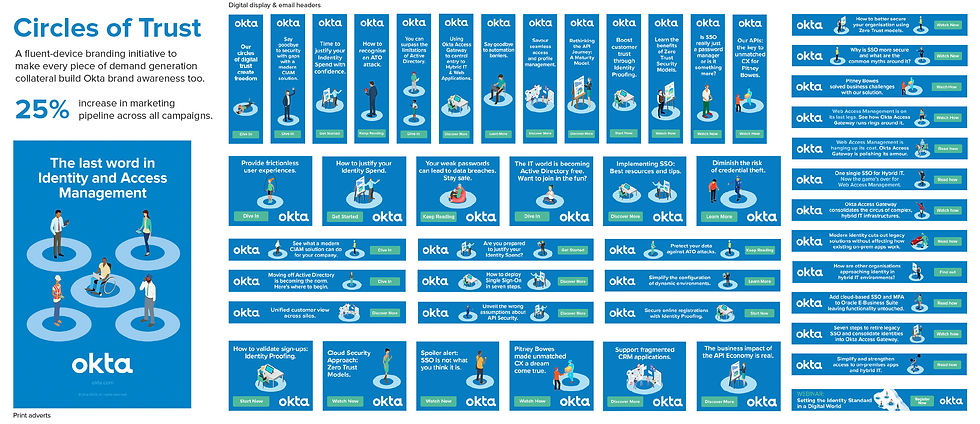Building B2B tech brand awareness without big budgets
- Alistair Ross

- Jul 31, 2023
- 4 min read
Updated: Sep 18, 2023

In the fast-paced world of B2B technology marketing, unifying, long-lasting brand positioning ideas are rare. As a quick test - try and link a familiar B2B tech brand with its positioning idea or mental shortcut. Hard, isn't it? Why is this? Do B2B tech brands not need positioning ideas to succeed? Do they simply rely on growing name awareness through events and sponsorship? Is the marketing function within B2B tech organisations less strategic than in B2C, where familiar brand ideas abound? Does siloing marketing into Product | Channel | Field | Partner | Brand teams impair a consistent approach? Or is the influence and tenure of the average B2B tech CMO simply not enough to bring a brand idea successfully to market? In our experience it's all of the above to greater or lesser degrees. Most B2B tech marketing teams are tasked with creating multiple strands of disparate tactical demand and lead generation activity in support of Sales. These campaigns are primarily targeted at audiences currently in market and visually connected by superficial design branding. Let's call it matching luggage marketing communications.
Communications that appear superficially from the same brand, but are not continually landing a consistent drip, drip, drip idea that builds associations in prospect's minds.
Advocating for a brand idea to position a B2B tech organisation and drive fame is often seen as a luxury, requiring separate investment. Investment that's more often than not a deal breaker. B2B tech marketers are instead instructed to focus on picking the fruit (those 5% prospects in market), rather than looking after the longer term health of the orchard too (the potential 95% who are future prospects influenced by brand activity). Building a brand idea without a brand budget
While most B2B tech brands use messaging to convey product superiority, tech buyers will almost always consider the brands they know more favourably. Brand familiarity, not product superiority, is what reassures audiences that they are short-listing the right organisations for consideration – and branding is what drives this mental availability.
Brands that advertise conspicuously with a consistent idea are subconsciously perceived as more trustworthy (ie: they have nothing to hide) and lower risk. Microsoft, a company that’s spent decades building its familiarity as a trusted and innovative solutions provider, still has the highest B2B brand value of any organisation globally [1]. Perhaps Microsoft's most famous brand idea ran from 1994-2002: Where do you want to go today? This was followed by the more corporate Your potential. Our Passion. from 2002-2011. Today it has achieved global familiarity, even if its positioning for the past decade is unclear.
But what if you don't have the deep pockets of Microsoft to grow awareness? What if there was a way to build brand awareness around an idea, expressed through all the tactical demand and lead generation activity, rather than through investing in a separate strand of brand awareness? After all, every touchpoint helps build the notion of a brand.
Generating greater emotional connection
You don't need big budgets to land a brand idea, if you have a smart approach. B2B buyers are just as human as the rest of us. They form their decisions based on fears and desires. And the emotional connections forged through the right brand idea help influence those decisions – with research claiming that “emotional advertising is twice as efficient as rational and delivers twice the profit” [2].

When LogicLogicMagic began working with Okta, their existing design language was based on circles, originating from the O in Okta. It was aesthetically pleasing, but this visual branding approach lacked any deeper, emotional meaning. Core to Okta's offering is the notion of trust. So LogicLogicMagic evolved the EMEA messaging and visual approach to support the more emotive, human idea of ‘Circles of Trust’.

At the heart of 'Circles of Trust' was a simple, low cost illustrative approach where those using Okta were visualised as protected inside blue 'Circles of Trust'. The isometric illustration approach is generic to B2B tech, but the consistent use of the blue 'Circle of Trust' device became a consistent and distinctive feature of Okta's EMEA marketing.

Importantly the approach was simple and small enough to be expressed across every single piece of marketing real estate from big event stands to tiny email signatures. Every touchpoint then became a reminder of the core brand idea. Drip, drip, drip. As a result Okta's brand awareness of their core promise grew across EMEA, and without needing to run 'brand advertising' as a separate channel.

Conclusion
Having a big brand idea that links together multiple strands of B2B marketing increases the probability of audience familiarity, consideration and success. But with the right approach it can be sewn into demand and lead generation activities to create a unified, integrated marketing approach that builds brand awareness simultaneously without needing significant additional budget. Interested? Contact Sinead@logiclogicmagic.com
If you want to learn more about the LogicLogicMagic approach and how we can help your organisation establish stronger connections with your target audience, you can download our quick guide: "11 ways to making technology marketing memorable", or the more comprehensive: "Mogic's guide to making marketing more memorable"
[1] Statista
[2] The Long and Short of It, Les Binet & Peter Field




Comments